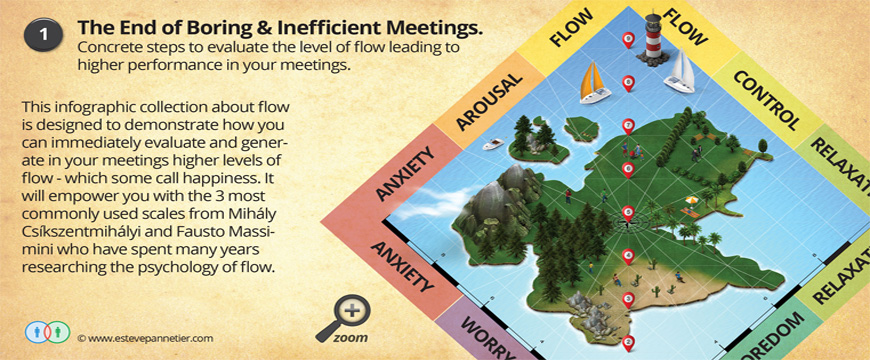
Youve heard coding geeks or gamers talking about being in the Zone" or creative directors being in a state of "creative flow. The concept of flow has existed for thousands of years but it was Mihály Csíkszentmihályi who named the theory in 1975, inspired by the metaphor of being carried by the flow of a river. Since then it has been present in the minds of Game Designers, HR managers and Work Psychologists. Unfortunately, only few professionals are able to evaluate flow on a daily basis, without the need for expensive consulting or academic research teams. Read on to try this out for yourself.
Your Reference Point
The meeting you choose to evaluate.
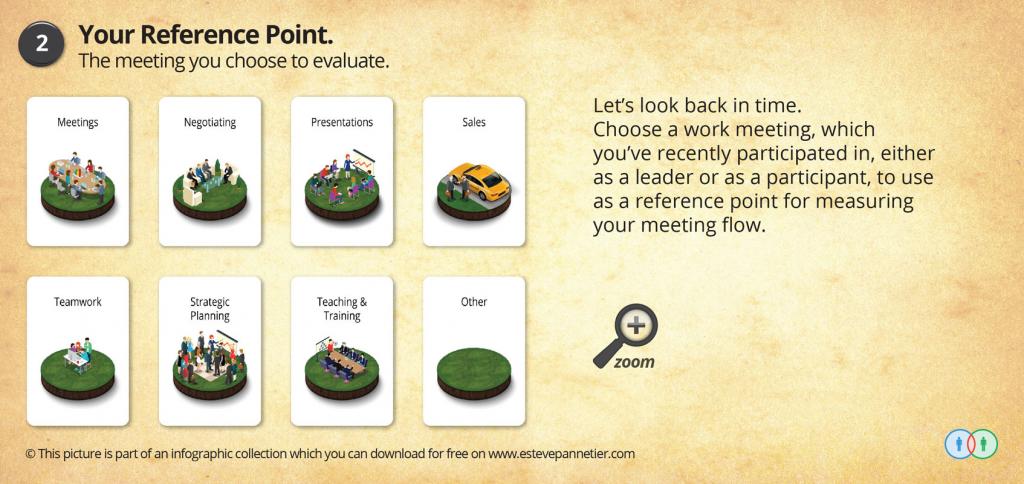
Your Motivation
How motivated were you to have an efficient and enjoyable meeting?
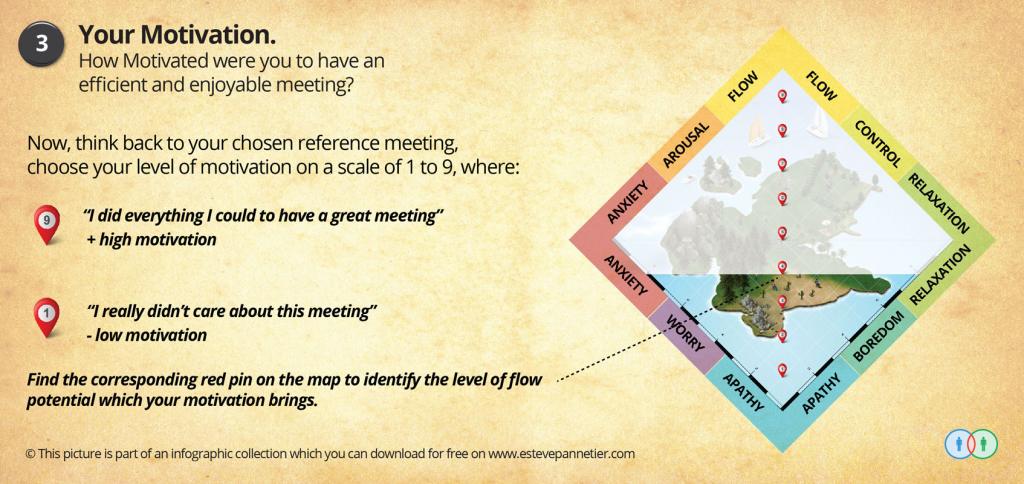
Your motivation score sets the maximum limit for your potential for flow. It gives an indication of how much flow you can hope to reach. You cannot have more flow than you have motivation. Like in the picture with a motivation score of 4, flow is still out of your reach. You need at least a motivation score of 5 to reach flow.
Motivation works in two ways: You need it for flow, but flow also creates more motivation. Unless you actually want to reach flow in a particular situation, its not going to happen.
Your Perceived Challenge & Skills
How challenging did the meeting feel and how competent did you feel in it?
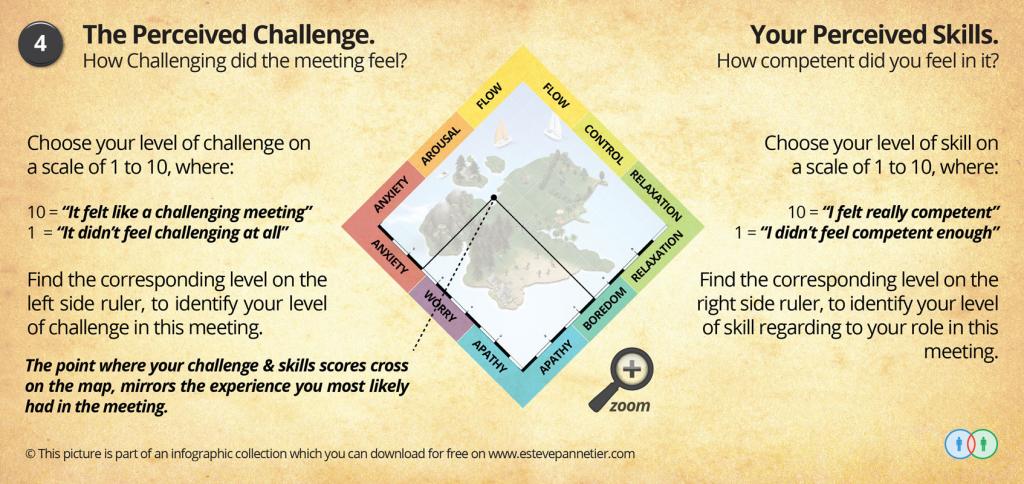
Your Results
How close did you get to the state of flow?
Read the descriptions for the triangular sector closest to your challenge and skill cross-point on the map. If for example your score was: Challenge 7 / Skill 5, you should read the description of the Arousal sector below. In case you landed on the border between 2 triangular sectors, read both descriptions.
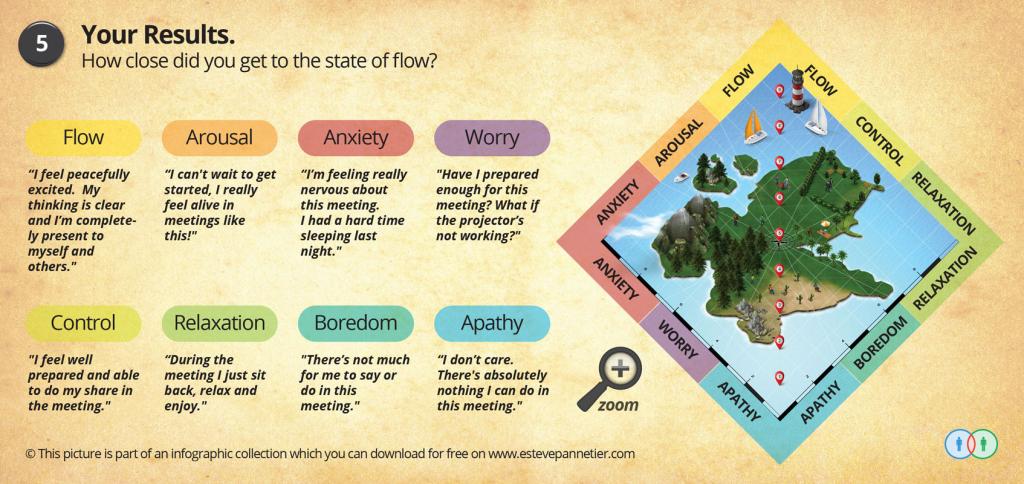
Does the description match your actual emotional experience of the meeting? If not, this may be a reflection of how honest you were with yourself about the level of challenge or the way you see your skills.
The 4 Zones
Which zone were you in?
Next, find which of the 4 zones you were in, and see what this means for your meeting.
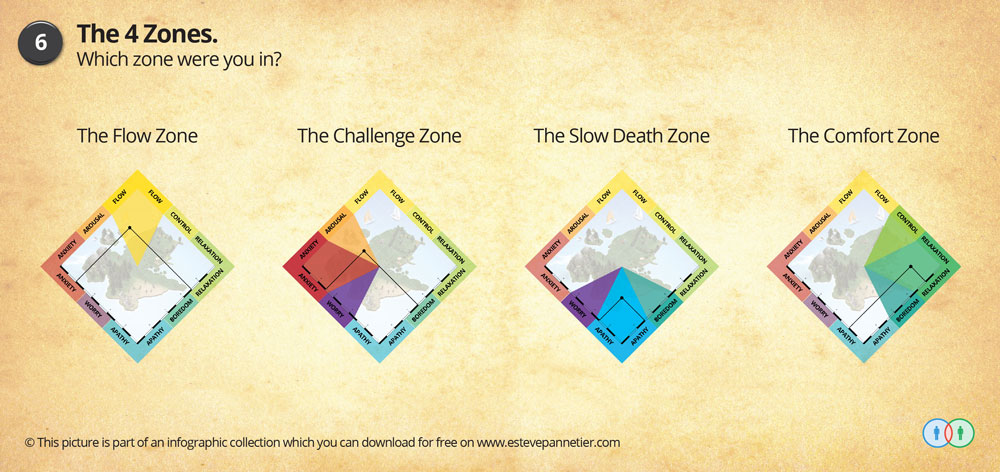
The Flow Zone
Did you experience flow? Congratulations!
You obviously had high motivation, which is a key condition for flow.
Your perceived challenge and skills in this specific meeting were in balance and high enough to create flow for you. While being in the flow, be aware of not loosing track of the process and time. If you are the only one in the flow, you are at risk of zoning out from others. You can help others and the whole group to find (and maintain) their flow, by bringing more structure to the process and timing of the meeting.
The Challenge Zone
You are used to firefighting, maybe you even enjoy the rush. You might have difficulties to prioritize your To Dos. You might be highly motivated but still more focused on getting things done instead of developing yourself and learning new skills. In this meeting your challenge level felt too high compared to your perceived skills. In order for you to reach flow you need to lower your challenges or increase your skills. You would benefit from taking more time for learning.
The Slow Death Zone
You didnt feel challenged in this meeting. Maybe you didnt even want to be involved in this meeting. You most likely chose to do just enough to get through the meeting. Motivation is the key focus in this zone. How much do you want to feel motivated? If you want to reach flow, you can always choose to learn and challenge yourself. You could try taking on a new role in your meetings to serve the groups purpose, while also enjoying new ways of interacting with others.
The Comfort Zone
You had enough skills for this meeting, but there wasnt enough challenge to keep you focused and on your toes. Maybe you are used to feeling so comfortable that you dont have the motivation to push yourself out of your comfort zone and pursue flow. If you dont do anything about this, there is a risk that you might fall into the Slow Death zone. If you want to be in the flow, you need new challenges to help you step out of your comfort zone. You can challenge yourself by taking a new active role in meetings to help the group. You can do this by being part of a "hosting team" for example by collecting the valuable meeting outputs as a harvester or leading the meeting differently as a host instead of a facilitator.
The Group Flow
How to get the best out of your team?
Group flow is different from individual flow. Individuals all reaching flow separately is not enough to create group flow. Only when people are working as a team towards a shared purpose can they hope to reach group flow. When the team agrees on common values, goals and use a specific process, they are more likely to get into group flow. Remember how groups bond better when facing a common crisis. Facing challenges together as a team helps to create group flow. The ability to cultivate flow plays an extremely important role in the workplace. Flow increases workplace satisfaction and productivity. It also improves morale. Serious Play facilitation methods like the GreenBlueRed™ Meeting toolbox are increasingly popular ways of creating and sustaining group flow in workplaces.
What about tomorrow?
How can you use this as a team leader or HR manager?
Use this quick self-evaluation of flow to help you to figure out if you need to take on more challenges or learn more skills. It is a powerful framework to manage your team, and even structure your teams growth over time. As a HR manager, if you are facing a brain-leak issue with your employees leaving, it can often be a problem of their positions not allowing them to find flow or be promoted. You can use the Flow Meter to build or improve the salary-grid and learning paths, and to help employees grow by matching their levels of challenge (through new projects or responsibilities) and learning.
You can get a clear and simple infographic summary of the Flow Meter from www.estevepannetier.com. Click the Please send me the free infographic Flow Meter with instructions and one will be sent to you shortly.
Estève Pannetier and Anu Timmerbacka are Meaningful Conversations and Influential Communication coaches who teach in Aalto EEs - Boosting your Leadership skills and AaltoJOKO® programs.













